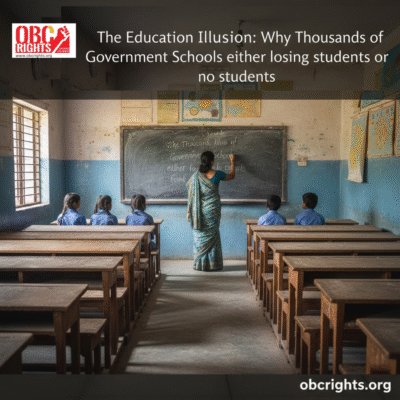India’s education system is often praised for its vast network of government schools, designed to provide free and accessible education to every child. Yet, recent data has exposed a troubling reality: nearly 8,000 government schools had zero student enrolments in the 2024-25 academic year, while continuing to employ over 20,000 teachers. This glaring mismatch raises urgent questions about governance, resource management, and the real priorities of policymakers. The issue is not just statistical; it reflects a systemic failure in ensuring that the promise of public education reaches every child.
The Enrolment of Students in Government Schools: A Crisis of Accountability
The fact that so many government schools have no students is more than a bureaucratic oversight—it is a failure of accountability at multiple levels. States like West Bengal, Telangana, and Madhya Pradesh top the list for zero-enrolment schools, suggesting that local administration and education departments are not auditing or rationalizing resources effectively. How can teachers be paid when there is literally no one to teach? How are school infrastructures maintained when there are no beneficiaries? i.e. students.
This situation exposes a deep-rooted inefficiency: despite decades of reforms and policies, the enrolment of students in government schools continues to decline, especially in rural and marginalized communities. In few cases, schools exist only on paper, serving as payroll points rather than centers of learning.
Why Are Students Avoiding Government Schools?
The decline in enrolment is not random; it reflects larger social and systemic issues:
- Perceived Poor Quality of Education: Parents often avoid government schools because of insufficient teaching materials, outdated curriculam, and poorly trained staff.
- Infrastructure Gaps: Many schools lack basic facilities like toilets, drinking water, and electricity, making them unfit for daily learning.
- Proliferation of Private Schools: With rising aspirations and aggressive marketing by private institutions, families often prefer fee-paying schools even when they struggle financially.
- Teacher Mismanagement: While there are teachers in these schools, absenteeism and lack of accountability reduce actual teaching hours, discouraging enrolment.
- Systematic – planned pollution/introduction of political agendas.
Each of these factors contributes to the ongoing crisis in the enrollment of students in government schools, demanding urgent policy attention.
The Government’s Role: Negligence or Policy Blindness?
The continued existence of thousands of zero-enrolment schools is not accidental—it is a consequence of systemic negligence. The government continues to fund salaries and maintenance without auditing effectiveness or student presence. This raises troubling questions:
- Are funds being utilized efficiently?
- Why is there no rationalization of schools in areas with declining populations?
- Are policymakers prioritizing infrastructure over actual learning outcomes?
By failing to address these issues, the government is allowing a silent crisis to fester, which ultimately undermines the right to education for children across the country.

A Call for Urgent Reforms
To reverse this trend, urgent steps must be taken:
- Regular Audits and Data Transparency: Every school should be monitored annually to track actual enrolments, teacher attendance, and learning outcomes.
- Rationalization of Resources: Zero-enrolment schools must be merged, relocated, or repurposed to ensure effective utilization of resources.
- Community Engagement: Local communities must have a say in school management to rebuild trust and improve enrolment of students in government schools.
- Focus on Quality: Infrastructure improvements, teacher training, and monitoring of teaching hours are essential to make government schools attractive to parents.
- There should be accountability to Heads of Institutions and Teachers on the performance of students.
Without these measures, the enrolment of students in government schools will continue to decline, leaving a generation of children behind while the system continues to operate as a “payroll machine.”
Conclusion
The crisis of empty government schools is not just a statistical anomaly—it is a wake-up call for policymakers and citizens alike. India cannot claim to prioritize education while thousands of schools operate without students. The enrolment of students in government schools is a metric of both social justice and governance, and its decline reflects a larger failure of policy execution and accountability.
Unless the government acts decisively to audit, reform, and rebuild public schools, the promise of universal education will remain an illusion-a payroll for teachers with no pupils to teach.



